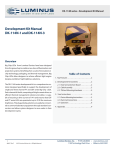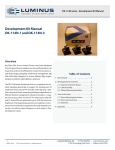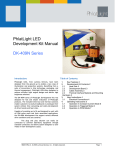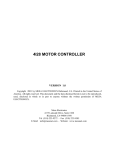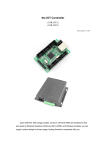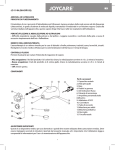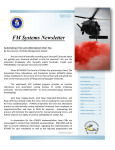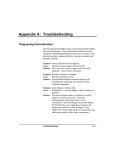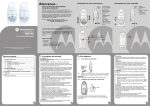Download DK-114N-1 - Luminus Devices
Transcript
PhlatLight LED Development Kit Manual DK-114N Series Introduction: Table of Contents PhlatLight LEDs, from Luminus Devices, have been designed from the ground up to enable a new class of illumination and projection systems. Benefiting from a suite of innovations in chip technology, packaging, and thermal management, PhlatLight LEDs allow designers to achieve efficient light engine designs and deliver high brightness solutions. Key Features . . . . . . . . . . . . . . . . . . . . . . . . . . . . . . . 2 The DK-114N series of PhlatLight Development Kits was designed for fast and simple evaluation of PhlatLight products. The included electrical and thermal solutions enable customers to easily breadboard or prototype their system without time consuming and costly development of driver boards and heat sinks. Capable of providing up to 14A and designed to work with all CBT and PT series parts and their associated applications, the DK-114N development kits support various different drive conditions and use scenarios. Available in single or multiple channel versions, the PhlatLight development kit will reduce development time of a PhlatLight based solution and provide a platform to build from. Development Kit Contents . . . . . . . . . . . . . . . . . . . . . . 2 Heat Sink and Driver Module . . . . . . . . . . . . . . . . . . 2 Interface Board . . . . . . . . . . . . . . . . . . . . . . . . . . . 2 Cable Assembly . . . . . . . . . . . . . . . . . . . . . . . . . . . 3 Thermal Interface Materials and Mounting Hardware . . 3 Use Instructions . . . . . . . . . . . . . . . . . . . . . . . . . . . . . 4 Additional Required Lab Equipment . . . . . . . . . . . . . 4 PhlatLight Device Mounting Instructions. . . . . . . . . . . 4 Electrical Setup Instructions . . . . . . . . . . . . . . . . . . 5 Operating Instructions . . . . . . . . . . . . . . . . . . . . . . 7 Appendix A: Electrical Design Considerations . . . . . . . . . 8 Appendix B: Isolated AC-DC Power Supplies . . . . . . . . . . 8 Appendix C: Mechanical Dimensions . . . . . . . . . . . . . . 10 Appendix D: Specifications of Driver Board . . . . . . . . . . 11 Appendix E: Driver Board Schematic . . . . . . . . . . . . . . 11 Appendix F: Cable and Connector Pinout Info . . . . . . . . 12 Appendix G: Future Iterations and Features . . . . . . . . . 12 © 2009 Luminus Devices, Inc. - All Rights Reserved 960017 Rev A PhlatLight® DK-114N Series Development Kit Manual Key Features Heat Sink / Driver Board Assembly • Drive any CBT or PT series PhlatLight LED up to 14A The heat sink and driver board are packaged together and mounted on a common metal substrate (Figure 2). The module can be left as a free-standing assembly on a bench-top or it can be mounted on an optical table by using the standard optical post mounted on the heat sink. • Pulse frequencies of greater than 40kHz possible • Analog current control via on-board potentiometers or external voltage • Simple current and voltage measurements • Fast rise and fall times - less than 1 microsecond • Fast current level switching - less than 5 microseconds Development Kit Contents The contents of each PhlatLight DK-114A Development Kit will depend on the number of channels ordered. As shown in Figure 1, each kit includes the following components: • Interface board • Heat sink/driver board assembly • Cable assemblies • Thermal interface materials and mounting hardware • User Manual Each interface board supports up to 3 channels. For configurations of greater than 3 channels, additional interface boards are included. Additional channels will increase the quantities of each of these components. The following sections describe the components in detail. This development kit was designed with flexible features to allow for easy evaluation of PhlatLight LEDs. It was not optimized for size or for direct integration in end products. However, the underlying circuit and thermal design can be used as a reference by system designers. To this effect, the complete design files including schematics, mechanical drawings, and bills of materials are available upon request. Figure 2: Heat sink / Driver board Assembly Heat Sink The heat sink is a high performance, low cost and compact air cooled aluminum extrusion. Measuring only 40 mm x 40 mm x 40mm, the heat sink occupies a very small volume. The typical thermal resistance from heat sink to ambient with the fan in operation is 0.6 ºC/W, thereby enabling significant power dissipation. The bolt pattern on the front face of the sink allows for easy mounting of all CBT and PT series modules. All modules can be mounted either horizontally or vertically, allowing for easy prototypes of systems. Driver Board The driver board, designed around National Semiconductor’s LM3433 IC, is designed to provide up to 14A of current to any PT or CBT series PhlatLight LED. The board is mounted close to the heat sink and LED to ensure cable lengths are kept at a minimum (<3”). Longer cable lengths will cause increased current ringing when pulsing the LEDs. Using a negative-rail, grounded common anode topology, the LM3433 driver board enables the anodes of multiple PhlatLight LEDs to be in electrical contact with each other. There is no need to electrically isolate the anodes of the LEDs from each other or the heat sink. Figure 1: Single Channel Evaluation Kit Contents © 2009 Luminus Devices, Inc. - All Rights Reserved Page 2 PhlatLight® DK-114N Series Development Kit Manual The driver board is fully capable of driving the LEDs in either CW or pulsed mode. PWM frequencies in excess of 40kHz are feasible. An external function generator is required for generating the pulse trains. Interface Board The included interface board is meant to serve as a clean interface from the user supplied lab equipment to the driver boards. Each interface board is capable of routing power and signal control to up to three driver boards. A potentiometer (POT) is included for all three channels to allow for manual adjustment of intensity. Alternatively, the current level can be controlled via a user supplied voltage signal, which allows for analog dimming. Likewise, there are inputs for a user supplied pulse train, which allows for pulsed width modulation (PWM) of the LEDs. Figure 4: Included Cable Assemblies For optimum performance, it is not recommended to increase the length of the driver to LED cable. A longer cable will result in decreased performance when pulsing the LEDs. Thermal Interface Materials (TIMs) and Mounting Hardware Also included in the kit are precut sheets of a high performance thermal interface material (eGraf HiTherm 1205) and the required mounting hardware for the devices. Figure 3: Interface Board Cable Assembly Each development kit includes all of the cables necessary for proper setup. The primary cables included are as follows: • Power supply to interface board • Interface board to driver board - power • Interface board to driver board - signal • Interface board to fan • Driver board to LED The interface board to driver board cables (power and signal) and the interface board to fan cable come bundled together. For pinout information, please refer to Appendix F. In the cases of using any of the C11 package types (PT85, PT120, CBT-85, CBT-90 and CBT-120), the driver board to LED cable is integrated into the driver board. Figure 5: Left picture: TIM cut for C21 package types. Right picture: TIM cut for C11 package types. Mounting screws for the various package types are included. M2x5 screws are provided for attachment of C21 package types (PT54, PT39, CBT-54 and CBT-40). M2.5x6 screws are provided for attachment of C11 package types (PT85, PT120, CBT-85, CBT-90 and CBT-120). © 2009 Luminus Devices, Inc. - All Rights Reserved Page 3 PhlatLight® DK-114N Series Development Kit Manual User Instructions The following procedure explains how to setup the PhlatLight Evaluation Kit. It is recommended that the table be equipped with ESD protection. Important Note: The driver board is capable of providing 14A of current to any device. Not all PhlatLight products can be powered at 14A. Care must be taken to ensure the proper current is applied to the device. Consult the product data sheets for current limitations of specific devices. Figure 6: PhlatLight device and an appropriate thermal interface material Equipment Required by User In order to power and use the development kit, some additional equipment is required. Table 1 lists the type of equipment as well as a suggested part. An additional list of other compatible power supplies is provided in Appendix B. Important Note: It is very important that the power supply feature an isolated output. If the AC input ground is tied to the DC output ground of the power supply, it will cause damage to the driver board. All of the recommended supplies feature an isolated output. Please refer to Appendix A for more information on these requirements. Lab Equipment 2. Prepare the heat sink surface by dusting or removing any particulates that have accumulated on the surface. Place the thermal pad on the heat sink with pre-drilled holes matching the hole pattern on the core board of the device (Figures 7 and 8). Recommended Part 12V Lab Power Supply Lambda ZUP20-20 Oscilloscope Tektronix TDS 3024B Waveform Generator Agilent 33220A Multimeter Fluke 187 Photodetector Thorlabs PDA10A Figure 7: Prepared heat sink with pre-drilled bolt pattern Table 1: Additional Lab Equipment PhlatLight Device Mounting Instructions The following procedure explains the process to properly mount a PhlatLight device to the included heat sink using the included thermal interface material and mounting hardware. The primary goal is to ensure there is good thermal contact between the backside of the copper core-board and the front face of the heat sink. 1. Use a thermal pad of an area slightly larger than the area of the core-board (Figure 6). Figure 8: C21 package type thermal interface material placed on heat sink 3. Place the device on the thermal pad, taking care that the hole patterns match (Figure 9). © 2009 Luminus Devices, Inc. - All Rights Reserved Page 4 PhlatLight® DK-114N Series Development Kit Manual age types, a cable is soldered to the board. The 12” cable assembly, which includes the interface board to driver board cables as well as the interface board to fan cable connects as shown in Figures 13 and 14. The 12” cable assembly, as shown in figure 13, connects the control board to a power supply. This connection is shown in figure 15. Figure 9: PhlatLight device placed on top of thermal interface material Important Note: In almost all cases, the connectors will only insert in one direction. Care must be taken not to force any of the connections as this may damage the connectors. In the case that the connector can be connected improperly, the connector and mating cable are clearly marked with either color coding or lettering. If powered with improper connections, damage can be caused to the LEDs and circuit boards. 4. Insert screws in the holes of the coreboard and tighten. To ensure equal pressure is exerted by all screws, alternate tightening each screw until the board is securely fastened (Figure 10). The device is now mounted and ready for electrical connections. Figure 11: CBT-54 LED to driver board cable interface Figure 10: Fully mounted PhlatLight device Electrical Connections The following sections assume that the user has all of the equipment listed in Table 1. 1. Prepare the power supply and ensure the power supply being used is capable of providing enough power to the devices. A single channel at full power will draw up to ~80W at 12V and 6.5A. If using a variable power supply like the Lambda ZUP2020, preset the voltage to 12V and set the current to the maximum. Power off the supply until all connections are established and the board settings are ready. 2. Attach all of the wiring included in the kit. The short, 3” Figure 12: CBT-54 LED to driver board cable interface cable connects the LED (C21 package types only) to the driver board as shown in Figures 11 and 12. For C11 pack© 2009 Luminus Devices, Inc. - All Rights Reserved Page 5 PhlatLight® DK-114N Series Development Kit Manual ables the channel and the other controls functionality of the board. The enable/disable jumper is located at the positions labeled “ENA1”, “ENA2” and “ENA3”. When these positions are open (not shorted), the channel is enabled. When they are closed (shorted), the channel is disabled. Position the enable/disable jumpers so that the two pins are closed (shorted). 4. For the other jumper, there are three different possible po- Figure 13: Driver board to interface board cable connections sitions for the jumper, each of which enables different functionality with respect to the control of the driver board. It is possible to enable the current controlling POT on the driver board or the POT on the interface board or to control the current via a 0-5V external input. Table 2 details the various different configurations. Jumper Location Function No jumper External 0-5 V current control J20 or J19 or J14 Driver POT current control J18 or J13 or J15 Control board POT current control Table 2: Control Board Jumper Locations Position the jumpers as necessary to enable the type of control required. Figure 14: Interface board to driver board cable connections The locations of these jumpers are shown in Figure 16. The central channel is detailed in the figure. The locations are identical in the other two channels. Figure 15: Interface board to power supply cable interface 3. On each channel of the interface board, there are two jumpers mounted. One of these jumpers enables or dis- Figure 16: Jumper Locations © 2009 Luminus Devices, Inc. - All Rights Reserved Page 6 PhlatLight® DK-114N Series Development Kit Manual 5. Rotate all of the current controlling POTs (located at “P1”, “P2” and “P3” on the control board and at “P1” on the driver board) counter-clockwise until they stop. The imbedded arrow should point towards the “10” on the POT. The POT is now set at the minimum current setting. tor in Ohms. The sense resistor value is 0.005Ω. The output value will the be current going to the LED in amps (A). 6. The evaluation kit is now ready to be powered on. Turn on the power supply. The supply will draw a small amount of power. 7. To turn on any channel, open the enable pin by removing the jumper. Both the fan on the heat sink and the LED will power on. Operating Instructions There are multiple different ways the PhlatLight DK-114N Development Kit can be operated. The LEDs can be driven in continuous, current controlled mode via on board POTs or through an external analog voltage. Additionally, each channel has inputs for an external function generator signal to pulse the LEDs and is capable of pulsing at frequencies of greater than 40kHz. Sense Resistor Test Studs Figure 17: Sense resistor location on driver board 1. To change the current when either the interface board or driver board is enabled, rotate the on board POT. Each POT will only function when enabled on the interface board. Clockwise rotation increases the current, while counter-clockwise rotation will decrease the current. attach a 0-5V signal to the ADJ test points. These are labeled “T3”, “T4”, “T7”, “T8”, “T11” and “T12”. Each test point is also labeled with either “GND” or “ADJ”. When hooking up the 0-5V signal, ensure that the ground cable is attached to the “GND” test point and the positive cable is attached to the “ADJ” test point. The current to the LED will adjust with the voltage signal. A higher voltage corresponds with a higher current. It is recommended not to exceed a 5V signal, as components may overheat. 3. To measure the current going to the LED, use a volt meter and measure the voltage across the sense resistor on the driver board. For ease of probing, two test studs have been placed to the left and right of “R15”. Figure 17 shows the location of the test studs on the driver board. Figure 18 shows a conversion plot between the sense resistor voltage and the current going to the LED. The current can also be calculated by the following formula: V Sense I LED = --------------R Sense Equation 1 where VSense is the voltage measured across the sense resistor in Volts (V) and RSense is the value of the sense resis- 16 14 LED Current (A) 2. To change the current when the external adjust is enabled, 18 12 10 8 6 4 2 0 10 30 50 70 90 VSense (mV) Figure 18: LED Current vs. Vsense voltage 4. To modulate the LEDs through PWM, connect a function generator to the test points labeled “PWM” and “GND”. These test points are also labeled “T1”, “T2”, “T5”, “T6”, “T9” and “T10”. The pulse output should be set to 0-5V, where 5V represents off and 0V represents on. Proper operation is best monitored by using a photo detector to observe the light output from the LED. Figures 16 - 18 show plots of typical waveforms. The device under test was a blue CBT-54 run at 14A and 50% duty cycle at 30kHz. Actual waveforms will depend on the specific driver © 2009 Luminus Devices, Inc. - All Rights Reserved Page 7 PhlatLight® DK-114N Series Development Kit Manual and LED being used. It is important to note that all PT and CBT series PhlatLight LEDs are built in a common anode configuration. That is, the copper core-board is at a positive electrical potential in operation. If this is not factored into the design, it becomes difficult to connect multiple devices to a common heat sink. The DK-114N development kit addresses this by configuring the devices in a grounded common anode topology. As a result, the LED anode is kept at ground and the cathode is at a negative potential. The LED anode can be in direct electrical contact with the heat sink without concern of electrical contact with other LEDs. It is important to note that while the heat sink is at ground, there is still power passing through it. For further information, please contact Luminus. Figure 19: Input and output (optical) pulse Figure 22: Grounded Common Anode Configuration Figure 20: Rise time example This configuration requires that the AC ground line from the supply providing power to the driver board is isolated from the DC ground line. A short list of isolated power supplies is provided in Appendix B. Appendix B: Isolated AC-DC Power Supplies Table 3 shows a list of isolated AC-DC power supplies. A power supply with isolated outputs is required to properly drive the DK-114N drivers. Failure to use a similar power supply will result in a malfunctioning board. Various different power supplies are listed in the table. For best efficiency, it is recommended to select a power supply that closely matches the required power. Figure 21: Fall time example Appendix A: Electrical Design Considerations © 2009 Luminus Devices, Inc. - All Rights Reserved Page 8 PhlatLight® DK-114N Series Development Kit Manual Power Manufacturer Input Output V/I Size Mounting Part # 30W CUI Inc. AC 85-264 VAC (47-400Hz) 12V / 2.5A 3.7” x 2” x 0.85” Thru-hole/SMT FSK-S30-12U 50W Omron AC 85-264VAC (47-63Hz) 12V / 4.2A 5” x 3.34” x 1.57” DIN Rail S8SP-05005 50W Lambda Power AC 90-264VAC (47-63Hz) 12V / 3A 3.62" x 1.46" x 6.26" Enclosed/Chassis mount SWS Series 60W Globtek Inc. AC 90-264VAC (47-440Hz 12V / 5A 5.24” x 2.39” x 1.62” External/Desktop DPS50 75W Lambda Power C 90-264VAC (47-63Hz) 12V / 6.3A 3.7" x 1.69" x 6.69" Enclosed/Chassis mount SWS Series 100W Lambda Power AC 90-264VAC (47-63Hz) 12V / 8.5A 3.78" x 1.77" x 7.4” Enclosed/Chassis mount SWS Series 100W Elpac Power AC 100-264VAC (47-63Hz) 12V / 8.3 7.36” x 4.33” x 2.32” External/Desktop FWP10012D8F-NC 125W Power-One Solutions AC 90-264VAC (47-63Hz) 12V / 10.5A 5” x 3” x 1.25” Open Frame MBP125-1012 120W AULT Inc. AC 100-264VAC (47-63Hz) 12V / 10A 9” x 2.9” x 2” Medical/External MW122RA12X XF01 150W Lambda Power AC 90-264VAC (47-63Hz) 12V / 12.5A 3.9" x 2" X 7.8" Enclosed/Chassis mount SWS Series Table 3: List of AC/DC power supplies with an isolated output © 2009 Luminus Devices, Inc. - All Rights Reserved Page 9 PhlatLight® DK-114N Series Development Kit Manual Appendix C: Mechanical Dimensions © 2009 Luminus Devices, Inc. - All Rights Reserved Page 10 PhlatLight® DK-114N Series Development Kit Manual Appendix D: Specifications of Driver Input Specifications Value Unit Note Input Voltage 12 V Max Supply current/channel 7 A Efficiency >90 % Output Specifications Value Unit Max output current 17 A Output current ripple (pulsed) <10 % Output Pulse Rise time <1 us Output Pulse Fall Time <1 us Output Setting Time <5 us min current to max Control Specifications Value Unit Note Max Pulse Frequency >40 kHz Duty Cycle Range 0-100 % Note Of set current Table 4: Driver board Specifications Appendix E: Driver Board Schematic and Pinout © 2009 Luminus Devices, Inc. - All Rights Reserved Page 11 PhlatLight® DK-114N Series Development Kit Manual Appendix F: Cable and Connector Pinout Info LED Pin Driver Board Pin Comment Interface Board Pin Driver Board pin Comment Pin 1 Pin 1 Thermistor Pin 1 Pin 1 GND Pin 2 Pin 2 Thermistor Pin 2 Pin 2 Analog ADJ Pin 3 Pin 4 Pin 6 LED Cathode Pin 3 Pin 3 POT Pin 4 Pin 4 Enable Pin 8 Pin 10 LED Cathode Pin 4 Pin 5 Pin 5 PWM Pin 5 LED Cathode Pin 6 Pin 6 Vinx Pin 12 Pin 14 Pin 7 Pin 7 Thermistor Pin 6 Pin 3 Pin 5 LED Anode Pin 8 Pin 8 Thermistor Pin 7 Pin 7 Pin 9 LED Anode Pin 8 Pin 11 Pin 13 LED Anode Table 5: Interface Board to Driver Board, Signal Interface Board Pin Driver Board pin Comment Pin 1 Pin 1 -12V Pin 2 Pin 2 -12V Pin 3 Pin 3 -12V Pin 4 Pin 4 GND Pin 5 Pin 5 GND Pin 6 Pin 6 GND Table 6: Interface Board to Driver Board, Power Table 9: LED to Driver Board, C21 Package Style LED Pin Driver Board Pin Color Comment Pin 1 N/A Green LED Anode Pin 2 N/A Yellow LED Cathode Table 10: LED to Driver Board, C11 Package Style Appendix G: Future Iterations and Features Interface Board Pin Fan pin Comment Additional features and other enhancements to the development kits are always in process and in development. Among the planned additional features are: Pin 1 Pin 1 +12 • Thermistor test points for active monitoring of thermistor Pin 2 Pin 2 GND • Built-in pulse train generator for simple PWM testing Table 7: Interface Board to Fan Interface Board Pin Color Comment Pin 1 Red +12 Pin 2 Black GND • Built-in fan controller to regulate junction temperature • Computer based interface for power and color control For more information about these features, please contact Luminus Devices. Table 8: Interface Board to Power Supply © 2009 Luminus Devices, Inc. - All Rights Reserved Page 12 PhlatLight® DK-114N Series Development Kit Manual The products, their specifications and other information appearing in this document are subject to change by Luminus Devices without notice. Luminus Devices assumes no liability for errors that may appear in this document, and no liability otherwise arising from the application or use of the product or information contained herein. None of the information provided herein should be considered to be a representation of the fitness or suitability of the product for any particular application or as any other form of warranty. Luminus Devices’ product warranties are limited to only such warranties as accompany a purchase contract or purchase order for such products. Nothing herein is to be construed as constituting an additional warranty. No information contained in this publication may be considered as a waiver by Luminus Devices of any intellectual property rights that Luminus Devices may have in such information. PhlatLight® is a registered trademark of Luminus Devices, Inc., all rights reserved. This product is protected by U.S. Patents 6,831,302; 7,074,631; 7,083,993; 7,084,434; 7,098,589; 7,105,861; 7,138,666; 7,166,870; 7,166,871; 7,170,100; 7,196,354; 7,211,831; 7,262,550; 7,274,043; 7,301,271; 7,341,880; 7,344,903; 7,345,416; 7,348,603; 7,388,233; 7,391,059; Patents Pending in the U.S. and other countries. Luminus Devices 1100 Technology Park Dr. Billerica, MA 01821 978-528-8000 (T) 978-528-8001 (F) E-mail: sales@luminus.com www.luminus.com © 2009 Luminus Devices, Inc. - All Rights Reserved Page 13













